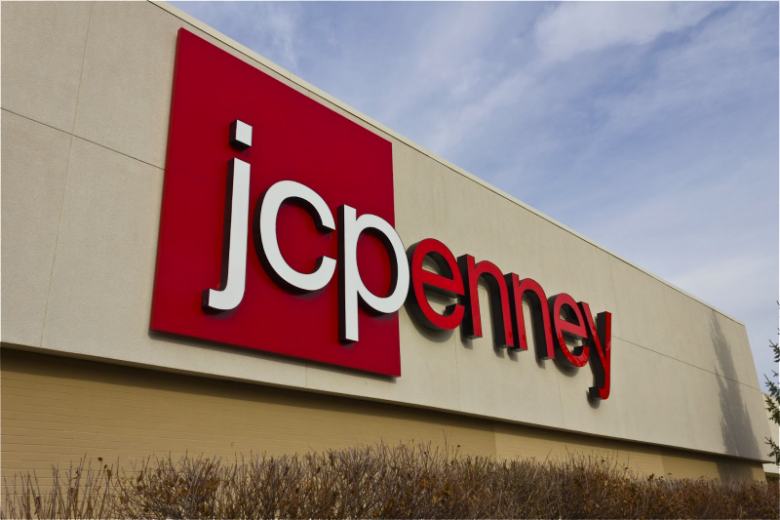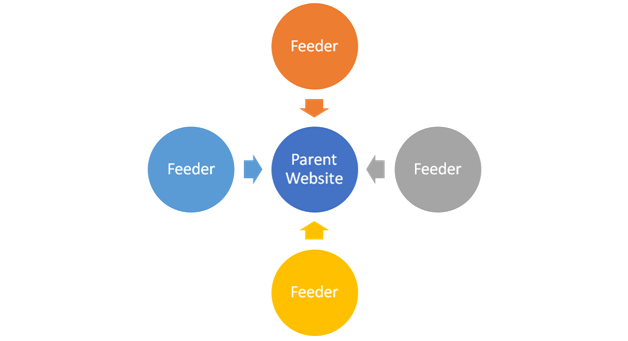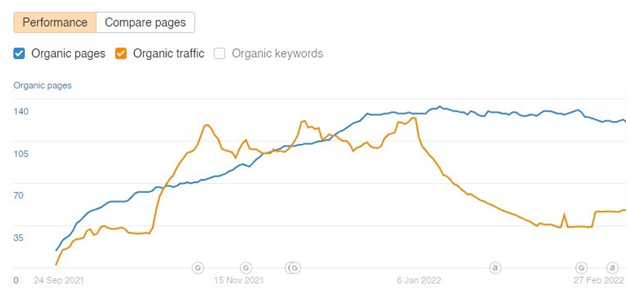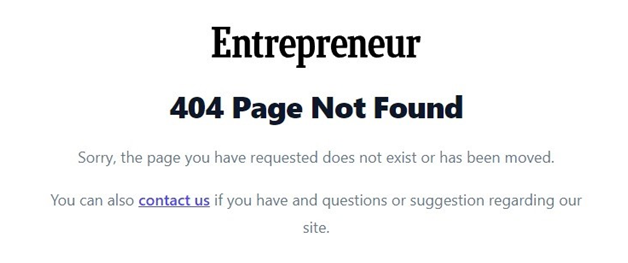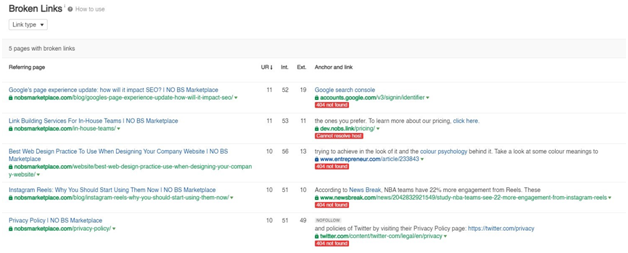What Is A PBN and Are They Really That Bad?
-
Aaron Gray
- Blogs
-
September 30 , 2022
-
12 min read
At the height of the holiday season in 2010, American fashion brand JCPenney was caught in a major SEO scandal. In a report by The New York Times published a few months later, an SEO professional discovered over 2,000 pages that lead back to the brand’s official website, complete with relevant keywords.
Nothing unusual, right? Well, take a look at this excerpt David Segal wrote in The New York Times in 2011 that explains the whole situation further:
Some of the 2,015 pages are on sites related, at least nominally, to clothing. But most are not. The phrase “black dresses” and a Penney link were tacked to the bottom of a site called nuclear.engineeringaddict.com. “Evening dresses” appeared on a site called casino-focus.com. “Cocktail dresses” showed up on bulgariapropertyportal.com. “Casual dresses” was on a site called elistofbanks.com. “Semi-formal dresses” was pasted, rather incongruously, on usclettermen.org.
Following the discovery, Google’s webspam master at the time, Matt Cutts, replied via Twitter that Google had taken decisive action—both algorithm and manual. JCPenney later released an official statement and promptly ended its partnership with its SEO contractor.
As you can see, nothing irks search engines more than relevant keywords embedded on irrelevant web pages. Search for “black dresses” and end up with a search result that leads to a website about nuclear engineering. Other keywords would’ve made use of that website better. More importantly, this story shows another thing that search engines loathe as much—private blog networks (PBNs). There’s a reason Google removed them from the list of legitimate SEO practices years ago. But are they as bad as Google or other search engines make them out to be?
What is a PBN?
According to Ahrefs, a PBN is a network of websites designed to pass link equity, or “juice,” to their parent websites. A typical setup appears somewhat like this:
A website employing a PBN can have hundreds of these feeder websites. The system takes advantage of backlinking by making it appear that the parent website has earned the links through these feeders. These multiple votes of confidence can lead Google to list the parent site higher in its results pages.
PBNs were prevalent before the Penguin update, specifically Penguin 4.0 in 2016. Back then, even reputable SEO professionals depended on PBNs to help sites rank favourably. One reason for its effectiveness is that Google determined a website’s authority primarily through PageRank at the time. Regardless of quality, the more sites linking to the parent, the better.
For the record, Google still uses PageRank as a factor today. But it’s only one of the hundreds of factors determining how a website should rank. On top of that, Google will penalise any website that tries to manipulate PageRank, PBNs being one example. Most PBNs have a tell-tale sign to showcase they are a PBN, and that is they have a home page, about us page, write for us page and a few category pages as seen in this screenshot below.
Why do sites resort to PBNs?
Despite Penguin 4.0 banning the building and managing of PBNs, many websites still practice it years later. Experts cite two reasons they still continue to exist:
- White hat link building is costly and erratic
If real-life economics has taught anyone one thing, the correct choices often carry hefty price tags. Want that smartphone loaded with the latest features? It’s going to cost an arm and a leg. Want your dream kitchen or bathroom to come true? You’ll need the most skilled remodelling contractor money can buy.
Legitimate SEO practices like link building aren’t any different. In one expert’s estimate, manual link building costs between USD$100 and USD1,500 (AUD$151 and AUD$2,264) per link. Another expert even believes it should cost more than that but understands that some companies won’t spend thousands on links.
Even if a company pays a fortune for hundreds of links, link building can’t guarantee positive results. Organic search goes where it wants to go. In the example below, organic traffic rises when the number of organic pages is low but drops when the number of pages is high.
A website can have all the quality content it wants, but it’ll still require high authority sites to refer to it. With PBNs, websites don’t have to worry about referring sites, as they could create their own. Feeder websites don’t necessarily have to be intricately designed as their only purpose is to pass link juice. Though some have to look legitimate to avoid Google’s watchful eyes. While some website design services cost a premium, others offer monthly rates as low as AUD$8.
- Websites have more control over anchor texts
Anchor texts let Google know what a specific piece of content is. For instance, this blog post is about PBNs, so one appropriate anchor text would be “private blog network.”
The more specific a keyword gets, the easier a page can rank. These long-tail keywords might not yield the most number of searches, but they constitute the majority of search traffic. On top of that, they have a higher chance of converting leads into paying customers. Here’s a great screenshot from WordStream on the engagement of customers for specific long tail keywords.
Penguin mandated this change, which meant having less control over the kind of anchor texts websites want. Some considered this a necessary sacrifice, but others still wanted control. As a result, it isn’t unusual to see content with anchor text like “Click here” or a naked URL. With natural referrals, demanding the kind of anchor text you want is almost impossible. On the other hand, PBNs allow websites to influence the anchor text, preferably keyword-rich ones. Sometimes, they make the text too rich.
Why did Google kill PBNs?
It’s worth noting that Google didn’t develop the Penguin update to go after PBNs specifically. Instead, it was a follow-up to the Panda update. The Panda update began Google’s war against low-quality content in 2011. Penguin was designed to catch the kinds of webspam that Panda couldn’t, and PBNs were among those caught in the net.
Two prominent practices Penguin outlawed include keyword stuffing and link schemes. PBNs belong to the latter. Google discovered that link schemes manipulated the algorithm to a site’s advantage by pushing unnatural links.
But it’s time to understand PBNs in a moral context. Imagine you’re a business that adheres to Google’s guidelines and constantly produces well-made content. Despite having trouble getting big-name sites to share your link, your website’s doing relatively well on the results page.
Then comes a competitor site you last saw at rock bottom that suddenly overtakes yours on the rankings. Sensing something fishy, you look into how that site gained the edge and discover a network of strange sites linking to it. Google’s algorithm would have flagged this immediately, but without the Penguin update, your site would lose to an unfair advantage.
So are PBNs wrong then?
Years after Penguin, the SEO community remains divided on the matter. While Google deems PBNs unethical, most SEO experts believe that isn’t always the case. For instance, look at this footer from bhg.com.au.
The section enclosed in red refers to bhg.com.au’s network of other websites. It almost feels like a PBN, but would Google penalise websites with quality content like this?
Or this?
That’s the trouble with one of the most pervasive myths about PBNs: multiple websites with a single owner. A business owning various websites, provided that each adheres to an acceptable degree of quality, isn’t necessarily a PBN. This arrangement works for companies that operate storefronts worldwide, as each website can cater to a specific country.
Another common myth is that Google’s algorithm has grown so advanced that it can easily spot PBNs. While Penguin was a significant upgrade, people will always find novel ways to work around it. In this case, PBN practitioners spread their feeders over various hosting services and diversify their designs to avoid being flagged.
Perhaps the better question is…
Is the risk worth it?
If a PBN does get caught in Penguin’s net, the consequences can be dire. According to an owner of several niche websites, they saw their sites’ overall traffic tank by 80%–90% in just a weekend. This decline can result in lost income amounting to thousands of dollars every month. The owner believed it was worth the risk because of the four-figure income it brought them. But after this, they never returned to doing PBNs again.
A far lesser sentence would be that Google ignores the links from the feeders. There will be no manual penalty, but the links won’t impact a website’s rankings. Google confirmed a few years back that it ignores these types of links more often than slapping manual penalties.
In the end, the answer depends on how you do your SEO. Do you prefer playing it safe or playing high stakes? If Google catches your website red-handed, will it be able to recover? No expert can answer that—just you.
Is there a better way?
Yes. It’s called white-hat link building.
Expensive and unpredictable as it can be, white-hat link building is the best way to remain on Google’s good side. It produces results that feel like the business is giving actionable advice to their clients, as the 21st-century internet should. In doing so, you can reduce bounce rates and improve your link profile. Below are several approaches you can apply:
- Reaching out to the media
For the record, this approach is anything but easy. You may submit a Pulitzer-worthy piece to media outlets, but everyone else is doing the same. The content can get buried under other submissions, especially while something significant is happening. But when you do it right, the rewards are definitely worth the hurdles.
One way is through Help A Reporter Out (HARO). HARO hosts press releases and connects reporters with thousands of bloggers and journalists online. However, don’t rule out searching for more direct opportunities.
Businesses may have to modify their content to suit media publications. If possible, include several images, videos, or charts in the content. Multimedia press releases attract as much as six times more engagement than plain text.
- Being a guest contributor
A much easier method is contributing content to a third-party publisher’s blog or website. It doesn’t necessarily have to belong to a prominent news outlet. You can contribute to someone’s blog or a niche-specific website. If your content follows the publisher’s guidelines, you have a greater chance of getting published here.
Guest blogging, as it’s called, has three objectives: (1) establish a business’s authority, (2) lead traffic to the business’s websites, and (3) encourage backlinking. However, as renowned SEO expert Neil Patel stresses, guest blogging shouldn’t be primarily focused on the third goal. Doing so won’t make it any different from managing a PBN.
Using a publisher with a different niche to publish your content is a big no-no. As explained in the JCPenney news story, search engines hate content that doesn’t fit the website’s niche. They won’t hesitate to demerit the content because it provides little to no help to the reader.
- Resolving broken link issues
Over time, some links in the article or post can die out, either their domains have changed or shut down for good. In this case, it pays to inform the website administrator to get them up and running again as soon as possible. Otherwise, the business will miss out on the link juice.
The most prevalent type of dead link is a 404 error. It simply means that the link no longer exists because it’s either deleted or moved.
Some dead links may result from a missing letter or symbol in the URL. The user’s browser will notify them. Here’s a prompt from Microsoft Edge:
Online tools such as Ahrefs can detect links that have issues. Some tools even specify the reason for the flagging.
Conclusion
Because of their ability to take advantage of loopholes in Google’s earlier algorithms, PBNs are all but banned from general SEO. Building and managing one no longer makes economic sense, given the harsh penalties that await an offending website. Still, some professionals manage PBNs because of their low cost and greater control over keywords.
In the end, whether or not PBNs are wrong in your eyes depends on the way you optimise your site. Google’s updates aren’t legally binding, so PBNs won’t get anyone arrested. If you don’t want to risk earning the search engine’s wrath, then play by white-hat rules. Prioritise quality content over practices that should’ve been banned ages ago.
Want to know the kind of SEO that won’t get you in trouble? Try our SEO services today to see the difference.
Subscribe to Our Blog
Stay up to date with the latest marketing, sales, service tips and news.



